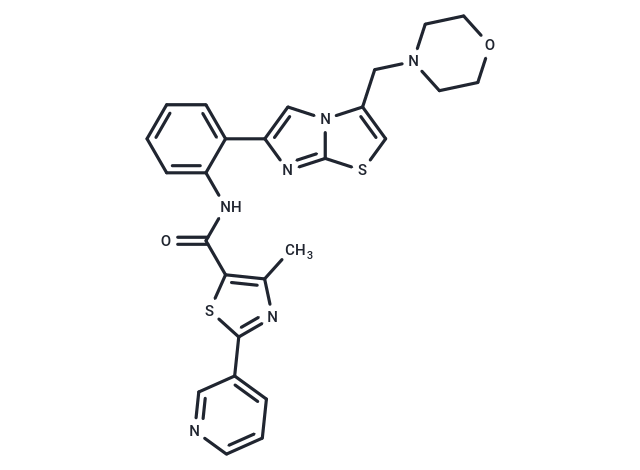Shopping Cart
- Remove All
 Your shopping cart is currently empty
Your shopping cart is currently empty

SRT 2104 (GSK2245840) is a selective and brain-permeable SIRT1 activator.

| Pack Size | Price | Availability | Quantity |
|---|---|---|---|
| 1 mg | $38 | In Stock | |
| 5 mg | $89 | In Stock | |
| 10 mg | $133 | In Stock | |
| 25 mg | $243 | In Stock | |
| 50 mg | $397 | In Stock | |
| 100 mg | $593 | In Stock | |
| 200 mg | $848 | In Stock | |
| 500 mg | $1,290 | In Stock | |
| 1 g | $1,730 | In Stock |
| Description | SRT 2104 (GSK2245840) is a selective and brain-permeable SIRT1 activator. |
| In vitro | SRT2104 reduces p65/RelA acetylation levels in C2C12 cells.[1] |
| In vivo | In male C57BL/6J mice, SRT2104 (100 mg/kg, p.o.) extends both mean and maximal lifespan of mice fed a standard diet, and enhances motor coordination, bone mineral density, and insulin sensitivity and decreased inflammation. Short-term SRT2104 treatment preserves bone and muscle mass in an experimental model of atrophy.[1] In Male N171-82Q HD mice, SRT2104 (diet containing 0.5% SRT2104) effectively penetrates the blood-brain barrier, attenuates brain atrophy, improves motor function, and extends survival.[2] |
| Kinase Assay | SIRT1 fluorescence polarization assay and HTS: In the SIRT1 FP assay, SIRT1 activity is monitored using a 20 amino acid peptide (Ac-Glu-Glu-Lys(biotin)-Gly-Gln-Ser-Thr-Ser-Ser-His-Ser-Lys(Ac)-Nle-Ser-Thr-Glu-Gly–Lys(MR121 or Tamra)-Glu-Glu-NH2 ) derived from the sequence of p53. The peptide is N-terminally linked to biotin and C-terminally modified with a fluorescent tag. The reaction for monitoring enzyme activity is a coupled enzyme assay where the first reaction is the deacetylation reaction catalyzed by SIRT1 and the second reaction is cleavage by trypsin at the newly exposed lysine residue. The reaction is stopped and streptavidin is added in order to accentuate the mass differences between substrate and product. The fluorescence polarization reaction conditions are as follows: 0.5 μM peptide substrate, 150 μM βNAD +, 0-10 nM SIRT1, 25 mM Tris-acetate pH 8, 137 mM Na-Ac, 2.7 mM K-Ac, 1 mM Mg-Ac, 0.05% Tween-20, 0.1% Pluronic F127, 10 mM CaCl 2 , 5 mM DTT, 0.025% BSA, and 0.15 mM nicotinamide. The reaction is incubated at 37°C and stopped by addition of nicotinamide, and trypsin is added to cleave the deacetylated substrate. This reaction is incubated at 37 ℃ in the presence of 1 μM streptavidin. Fluorescent polarization is determined at excitation (650 nm) and emission (680 nm) wavelengths. |
| Cell Research | Cells are cultured in low glucose Dulbecco's modified Eagle's medium (DMEM) supplemented with 10% fetal bovine serum and penicillin–streptomycin. Cells are treated with vehicle (0.1% DMSO) or 3?μM?SRT2104 for 24?h and then harvested for protein and Western blotting.(Only for Reference) |
| Alias | SRT2104, sirtuin modulator, GSK2245840 |
| Molecular Weight | 516.64 |
| Formula | C26H24N6O2S2 |
| Cas No. | 1093403-33-8 |
| Smiles | Cc1nc(sc1C(=O)Nc1ccccc1-c1cn2c(CN3CCOCC3)csc2n1)-c1cccnc1 |
| Relative Density. | 1.46 g/cm3 (Predicted) |
| Storage | Powder: -20°C for 3 years | In solvent: -80°C for 1 year | Shipping with blue ice. |
| Solubility Information | Ethanol: < 1 mg/mL (insoluble or slightly soluble) H2O: < 1 mg/mL (insoluble or slightly soluble) DMSO: < 1 mg/mL (insoluble) |

Copyright © 2015-2025 TargetMol Chemicals Inc. All Rights Reserved.